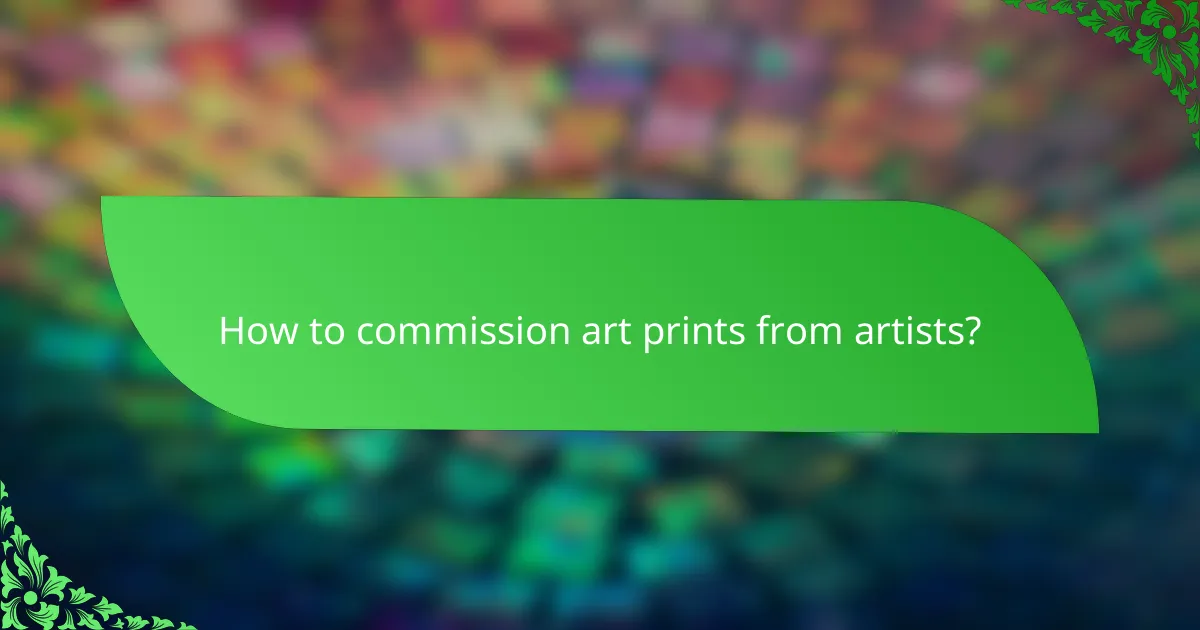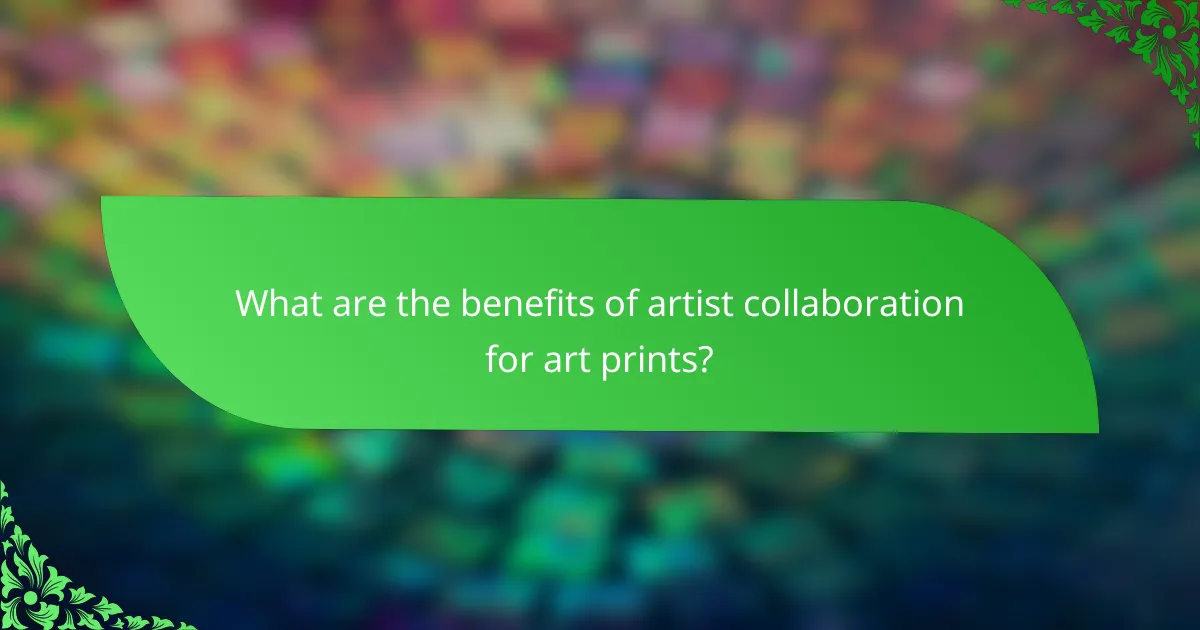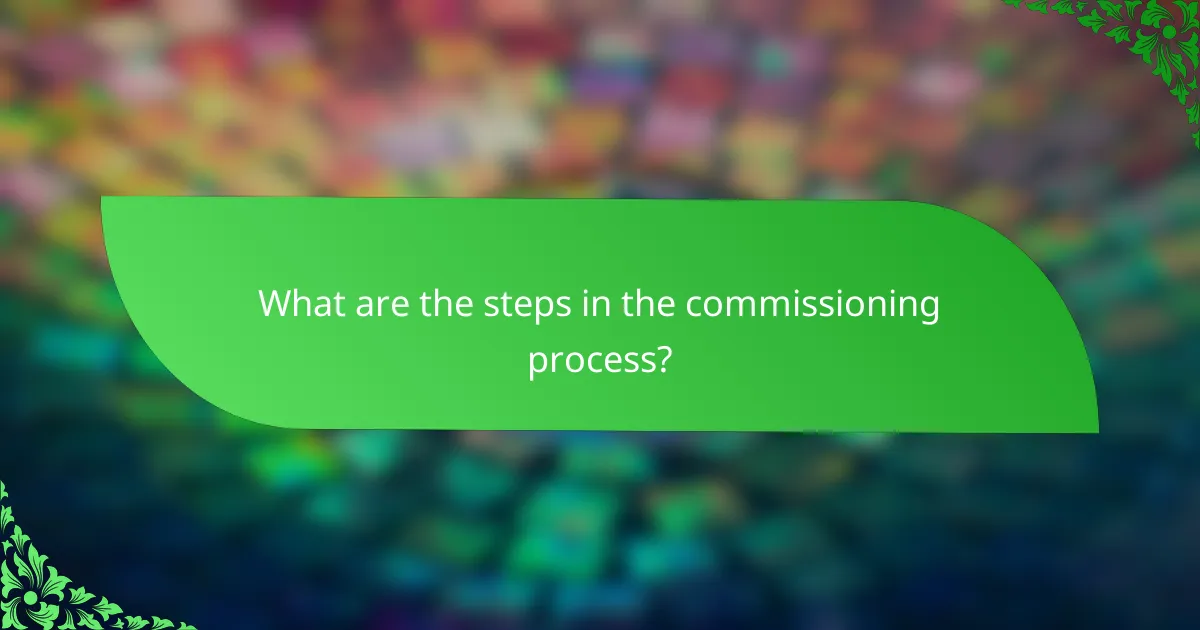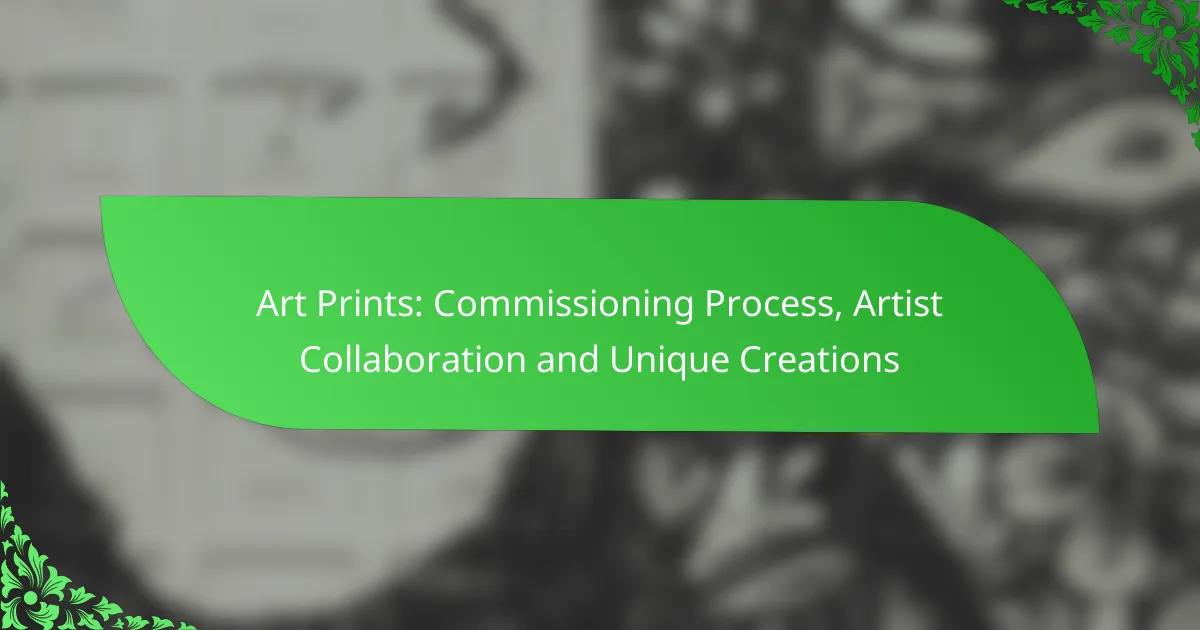Commissioning art prints is a unique opportunity to collaborate directly with an artist, resulting in a personalized piece that reflects your vision. This process involves selecting the right artist, defining project details, and establishing a budget and timeline, ensuring a tailored creation that resonates with your preferences. By engaging with artists, you not only gain access to diverse styles but also support local talent and foster community creativity.

How to commission art prints from artists?
Commissioning art prints involves a collaborative process where you work directly with an artist to create a unique piece tailored to your preferences. This process typically includes identifying the right artist, defining the project scope, setting a budget, establishing a timeline, and signing a contract.
Identify preferred artists
Start by researching artists whose style resonates with your vision. Look for portfolios online, visit local galleries, or explore social media platforms to find potential collaborators. Consider reaching out to art communities or forums for recommendations.
Once you have a shortlist, review their previous work and client testimonials to ensure they align with your expectations. This step is crucial as the artist’s unique style will significantly influence the final print.
Define project scope
Clearly outline what you want from the commission. This includes the size of the print, the medium (such as watercolor, digital, or mixed media), and any specific themes or subjects you have in mind. Providing reference images can help convey your ideas more effectively.
Discuss the level of detail and complexity you expect, as this will guide the artist in their creative process. Being specific about your vision will help avoid misunderstandings later on.
Set budget parameters
Establish a realistic budget for your commissioned art print. Prices can vary widely based on the artist’s experience, the complexity of the work, and the materials used. It’s common for commissions to range from a few hundred to several thousand dollars.
Be upfront about your budget when discussing with artists, as this will help them tailor their proposals to fit your financial constraints while ensuring quality work.
Establish timeline
Determine a timeline for the project, including when you would like to start and when you expect to receive the final piece. Keep in mind that artists often have multiple projects, so flexibility may be necessary.
Communicate your deadlines clearly and check with the artist about their availability. A well-defined timeline helps manage expectations and ensures that both parties are on the same page.
Sign contract agreements
Before the work begins, it’s essential to formalize the agreement with a contract. This document should outline the project details, payment terms, timeline, and ownership rights of the final artwork. Having everything in writing protects both you and the artist.
Review the contract carefully and ensure that all aspects of the commission are covered. This step can prevent disputes and misunderstandings during the creative process.

What are the benefits of artist collaboration for art prints?
Artist collaboration for art prints offers numerous advantages, including access to diverse styles, personalized artwork, and the opportunity to support local artists. These benefits enhance the overall experience of commissioning art while fostering creativity and community engagement.
Access to unique styles
Collaborating with artists allows you to explore a wide range of unique styles that may not be available through traditional art channels. Each artist brings their own perspective and techniques, resulting in distinctive prints that stand out in your collection.
When commissioning art, consider discussing your preferences and inspirations with the artist. This dialogue can lead to innovative interpretations and styles that align with your vision, creating a piece that is truly one-of-a-kind.
Personalized artwork
Commissioning art prints enables you to receive personalized artwork tailored to your specific tastes and needs. You can influence elements such as color schemes, themes, and sizes, ensuring that the final piece resonates with your individual style.
To maximize personalization, provide the artist with detailed information about your preferences and any specific elements you want included. This collaboration can lead to a more meaningful connection with the artwork, making it a cherished addition to your space.
Support for local artists
By collaborating with local artists, you contribute to the sustainability of the local art community. Supporting these creators helps them thrive and continue producing unique works, enriching the cultural landscape of your area.
When commissioning art, consider seeking out artists from your local community. This not only fosters a sense of connection but also allows you to engage with the artist directly, enhancing the overall commissioning experience.

How to choose the right artist for your art print?
Selecting the right artist for your art print involves evaluating their style, experience, and how well they align with your vision. Consider their portfolio, client feedback, and your compatibility with their artistic approach to ensure a successful collaboration.
Review portfolios
Start by examining the artist’s portfolio to gauge their style and expertise. Look for a diverse range of works that resonate with your aesthetic preferences. Pay attention to the quality of their prints, the techniques used, and how their previous projects align with your vision.
When reviewing portfolios, consider the medium and themes the artist typically explores. This will help you determine if their artistic voice matches the concept you have in mind for your art print. A well-rounded portfolio often indicates versatility and skill.
Check client testimonials
Client testimonials provide valuable insights into the artist’s reliability and professionalism. Look for feedback regarding their communication, adherence to deadlines, and overall satisfaction with the final product. Positive testimonials can reassure you of the artist’s credibility.
Seek testimonials from clients who have commissioned similar works to what you desire. This context can give you a clearer picture of how the artist handles specific requests and whether they can meet your expectations.
Assess compatibility with vision
Ensuring compatibility with your vision is crucial for a successful collaboration. Discuss your ideas openly with the artist and gauge their enthusiasm and understanding of your concept. A good artist will engage with your vision and offer suggestions that enhance it.
Consider scheduling a consultation to discuss your project in detail. This interaction can reveal how well the artist interprets your ideas and whether their creative process aligns with your expectations. A strong connection can lead to a more fulfilling artistic outcome.

What are the steps in the commissioning process?
The commissioning process for art prints typically involves several key steps that guide the collaboration between the client and the artist. These steps ensure that the final artwork aligns with the client’s vision while allowing the artist to express their creativity.
Initial consultation
The initial consultation is the first step where the client and artist discuss ideas, preferences, and expectations. This meeting can take place in person, over the phone, or via video call. It’s essential to communicate the desired style, size, and subject matter during this stage.
Clients should prepare examples of artwork they admire and any specific themes or colors they want to incorporate. This helps the artist understand the client’s vision better and sets a solid foundation for the project.
Concept development
After the initial consultation, the artist begins developing concepts based on the discussed ideas. This phase may involve creating rough sketches or mood boards that capture the intended style and themes. The artist may present multiple concepts for the client to review.
Clients should provide feedback during this stage to refine the direction of the artwork. Clear communication about what resonates and what doesn’t is crucial to ensure the final piece aligns with the client’s expectations.
Approval of sketches
It’s advisable to establish a timeline for feedback to keep the project on track. Delays in approval can extend the overall timeline, so prompt communication is beneficial for both parties.
Final artwork delivery
Once the sketches are approved, the artist will proceed to create the final artwork. This phase may take several weeks to months, depending on the complexity and size of the piece. Clients should discuss delivery methods and timelines during this stage.
Upon completion, the artist will deliver the artwork, which may include framing or other presentation options. Clients should inspect the final piece upon delivery to ensure it meets their expectations and discuss any final adjustments if necessary.

What factors influence the pricing of commissioned art prints?
The pricing of commissioned art prints is influenced by several key factors, including the artist’s experience, the complexity of the artwork, and the size and materials used. Understanding these elements can help both artists and clients set realistic expectations regarding costs.
Artist experience level
The experience level of an artist significantly impacts the pricing of commissioned art prints. Established artists with a strong portfolio and recognition in the art community typically charge higher rates compared to emerging artists. This is due to their proven skills and the demand for their work.
When commissioning an artist, consider their background, previous works, and client reviews. While hiring a less experienced artist may save money, it could also result in a longer process or less satisfactory outcomes.
Complexity of the artwork
The complexity of the artwork is another crucial factor that affects pricing. More intricate designs, detailed illustrations, or custom themes require additional time and effort, which can lead to higher costs. For instance, a simple landscape may be priced lower than a detailed portrait with multiple subjects.
When discussing a commission, clearly outline your vision and any specific elements you want included. This will help the artist provide a more accurate quote based on the complexity involved.
Size and materials used
The size of the commissioned art print and the materials used also play a significant role in determining the price. Larger prints generally cost more due to the increased amount of time and resources required. Additionally, premium materials, such as high-quality paper or specialty inks, can further elevate the price.
When planning your commission, consider what size will best suit your space and what materials you prefer. Discuss these aspects with the artist to understand how they will affect the overall cost of the project.
